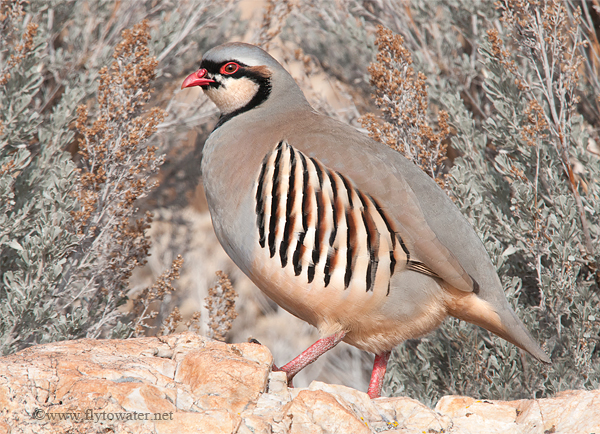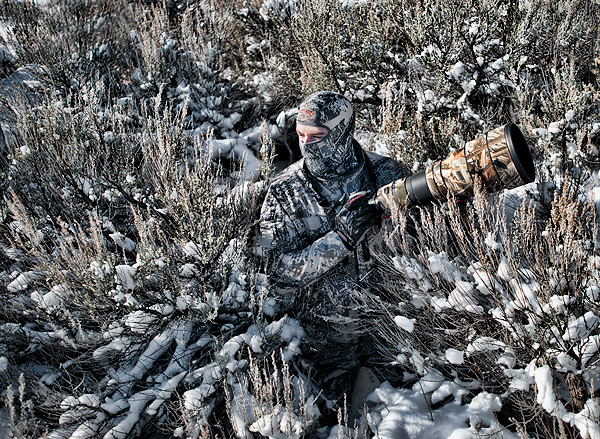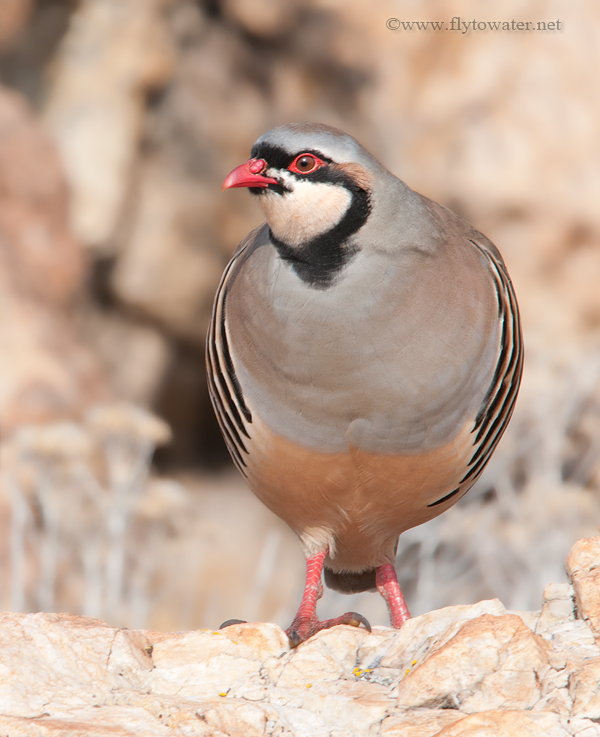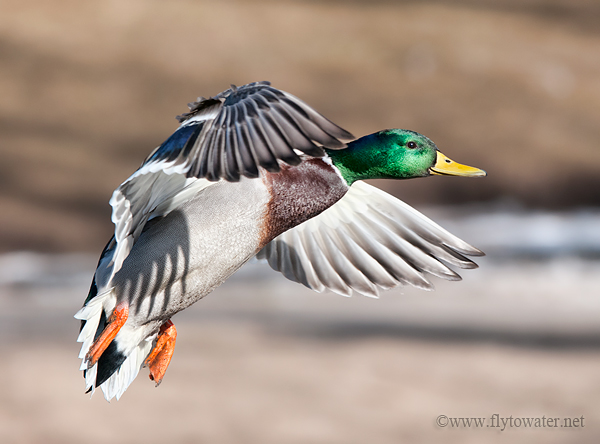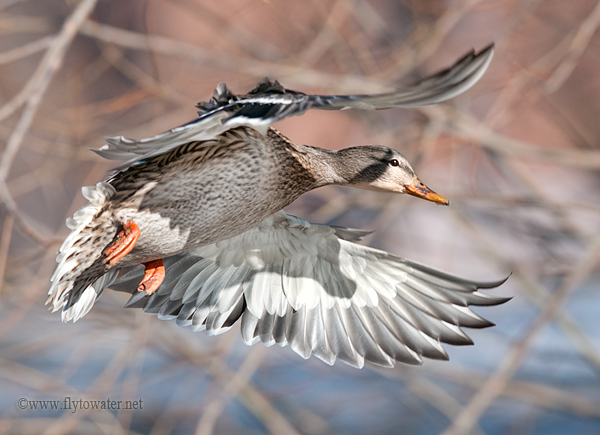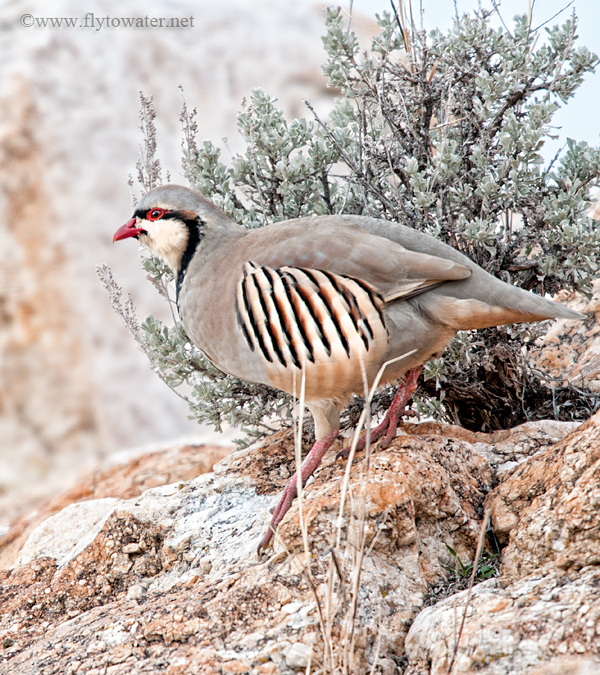I had been hiking for a while now. The ambient temperature was 14° F (-10° C), which was comfortable. A few years ago my outdoor wardrobe experienced some natural base layer enhancement courtesy of merino wool, which is a miracle fiber. Like your garden variety wool it insulates even when wet, but against the skin it does not itch and feels like fleece. Inexplicably it can also stave off odors for a remarkable amount of time, and it breathes extraordinarily well. I was glad to have my Icebreakers on this occasion. Incidentally, if you are one of my fly fishing readers, merino socks by this company are the dog's bollocks (meaning badass in the UK) for cold weather wading.
Chukar partridge were my goal for the day. Early in the Fall it's often possible to locate a covey by listening for calls, but typical of this time of year it was dead quiet. Wild birds soon realize their chatter is giving them away, and they start dishing out the silent treatment.
Hiking in the steep, rocky talus that chukars love with a 14-pound camera rig offers a pucker factor of about 9.0. Opportunities can be so unexpected and fleeting, I've never been able to successfully make use of a tripod, monopod, harness, or pack. It's all free-hand. At double the weight of a typical shotgun, and with the awkward size/shape of a big telephoto, the visual is like watching someone Riverdance on a cliff face while cradling a huge baby.
Presently due to insubordination on the part of my pulmonary system I stopped to catch a breather in a large boulder field. About 3 weeks ago I acquired the felicity of walking pneumonia and am still feeling the effects. After a minute or two, what I can only describe as a chukar whisper seemed to emanate from the rocks to my immediate left. The sound was barely audible, and far more subdued than I had ever heard before. My thought was that the call must have been more distant and I'd experienced a sound effect in the strewn boulders.
Following a few seconds of questioning the wisdom of combining thin air with cough syrup, I heard it again - "chuk-chuk." There were partridge about, and they were close. Really close - within feet. Over the last 25 or so years, I've hiked, hunted, scouted, and photographed in chukar habitat hundreds of times, and I can't say that I've ever managed to get nearer than 15 yards. Until now.
18 feet in front of me a mature, well-marked bird hopped up on a rock and was positioned ideally to catch the morning sun. Had I not been forewarned by the muted calls, which enabled me to raise my lens just in time, I have no doubt a flush would have been instantaneous. As it was, I captured a short series of images from spitting distance. At this range I believe my Sitka Gear Open Country camouflage probably made a huge difference, allowing me blend in under point blank scrutiny.
This was a great way to finish out 2011 - with a humbling opportunity that I was privileged to see through the viewfinder.
Nikon D300
Nikon 400mm f/2.8 VR - f/8, 1/320, ISO 400
Distance to Subject - 6 Yards/18 Feet
Tuesday, December 27, 2011
Devil Birds
Monday, December 26, 2011
The Eyes Have It
"Look at me when I'm talking to you!"
If you are a guy of they XY chromosome persuasion, chances are you have had this type of exclamatory remark flung in your direction. Due to a vast conspiracy between extroverts and chick flick producers, eye contact became an important, non-verbal communication element at some point in history.
While information technology professionals have been fighting this alarming and intrusive trend for decades via non-violent, downward gazing - such efforts have done little to stop the insanity.
Looking into the eyes establishes a connection. Similar body language is evident even in animals, where the direction of a stare or glance can have much deeper social meaning.
In wildlife photography, creating a linkage between the viewer and the image is paramount. Eyes are a critical component of the subject in this regard. Aside from intentional, artistic abstractions - successful images must capture the eye in sharp focus and without motion blur. This remains true regardless of distance and whether you are capturing a tight shot or broader environmental portrait.
It can be Hell's own fun tracking focus on the eye of a fast-moving bird while experiencing a fit of the galloping shivers. It's a perishable skill that takes practice. If you're looking to improve your technique, my suggestion is to find a location with a lot of mid-sized birds like seagulls which tend to congregate in groups and fly around in circular patterns. Use the same gear you take into the field, and rehearse focusing on the eye. You might get some odd looks bombing photos of gulls, but it's a small price to pay to avoid the opprobrium of eye blur when it counts.
Don't settle, like Kate Hudson did for Chris Robinson. If your intent is not an abstraction of some kind - the eye simply needs to be sharp. Make sure not to confuse missed focus with motion blur caused by a shutter speed which is too slow. Waterfowl will usually have some wing blur at 1/1250, with action freezing well at 1/1600. As a starting point select the camera's shutter priority mode on one of these two settings and adjust as conditions require.
Happy Holidays - and thanks for reading during 2011! I wish everyone a fantastic New Year.
Nikon D300
Nikon 400mm f/2.8 VR - f/5.6, 1/1600 (8x Optical Magnification) - Hand Held
ISO 400
Distance to Subjects: 20 yards/60 Feet
If you are a guy of they XY chromosome persuasion, chances are you have had this type of exclamatory remark flung in your direction. Due to a vast conspiracy between extroverts and chick flick producers, eye contact became an important, non-verbal communication element at some point in history.
While information technology professionals have been fighting this alarming and intrusive trend for decades via non-violent, downward gazing - such efforts have done little to stop the insanity.
Looking into the eyes establishes a connection. Similar body language is evident even in animals, where the direction of a stare or glance can have much deeper social meaning.
In wildlife photography, creating a linkage between the viewer and the image is paramount. Eyes are a critical component of the subject in this regard. Aside from intentional, artistic abstractions - successful images must capture the eye in sharp focus and without motion blur. This remains true regardless of distance and whether you are capturing a tight shot or broader environmental portrait.
It can be Hell's own fun tracking focus on the eye of a fast-moving bird while experiencing a fit of the galloping shivers. It's a perishable skill that takes practice. If you're looking to improve your technique, my suggestion is to find a location with a lot of mid-sized birds like seagulls which tend to congregate in groups and fly around in circular patterns. Use the same gear you take into the field, and rehearse focusing on the eye. You might get some odd looks bombing photos of gulls, but it's a small price to pay to avoid the opprobrium of eye blur when it counts.
Don't settle, like Kate Hudson did for Chris Robinson. If your intent is not an abstraction of some kind - the eye simply needs to be sharp. Make sure not to confuse missed focus with motion blur caused by a shutter speed which is too slow. Waterfowl will usually have some wing blur at 1/1250, with action freezing well at 1/1600. As a starting point select the camera's shutter priority mode on one of these two settings and adjust as conditions require.
Happy Holidays - and thanks for reading during 2011! I wish everyone a fantastic New Year.
Nikon D300
Nikon 400mm f/2.8 VR - f/5.6, 1/1600 (8x Optical Magnification) - Hand Held
ISO 400
Distance to Subjects: 20 yards/60 Feet
Saturday, December 3, 2011
Quote the Chukar
The chukar partridge (Alectoris chukar), is so named due it's distinctive call which sounds like "chuk." Native to locations in Asia such as the Himalayas and Nepal, it should come as no surprise that these little birds enjoy rugged terrain.
To describe the habitat chukars prefer as "steep" is to say that getting kicked in the gonads is bothersome. Somehow it doesn't adequately sum up the experience.
Hunters and photographers of these partridge can also be identified by their calls, which happen to rhyme with "chuk." It has been said that a person hunts chukars for the first time out of curiosity, and thereafter for revenge.
To me, no other game bird embodies the qualities of a survivalist quite like them. Living in the high desert foothills is a game of extremes. Water and food are scarce, and predators abound. The chukar is well suited to a harsh life, and is tremendously challenging to photograph.
Infiltrating a covey with 20+ sets of keen eyes, each pair honed by daily existence as a prey animal, can be an exercise in futility. Add rocky, vertical geography to the mix and it's downright sporty. If those were the only considerations involved, life would be good. Unlike the hunter, the photographer also needs to make it all happen during ideal lighting conditions and be positioned on the sunny side of the bird as the opportune moment arrives.
A truly complete image is rounded out by some supporting environmental elements within the frame, helping to add context to the scene.
To describe the habitat chukars prefer as "steep" is to say that getting kicked in the gonads is bothersome. Somehow it doesn't adequately sum up the experience.
Hunters and photographers of these partridge can also be identified by their calls, which happen to rhyme with "chuk." It has been said that a person hunts chukars for the first time out of curiosity, and thereafter for revenge.
To me, no other game bird embodies the qualities of a survivalist quite like them. Living in the high desert foothills is a game of extremes. Water and food are scarce, and predators abound. The chukar is well suited to a harsh life, and is tremendously challenging to photograph.
Infiltrating a covey with 20+ sets of keen eyes, each pair honed by daily existence as a prey animal, can be an exercise in futility. Add rocky, vertical geography to the mix and it's downright sporty. If those were the only considerations involved, life would be good. Unlike the hunter, the photographer also needs to make it all happen during ideal lighting conditions and be positioned on the sunny side of the bird as the opportune moment arrives.
A truly complete image is rounded out by some supporting environmental elements within the frame, helping to add context to the scene.
Some native grasses in the foreground, sage brush in the immediate background, and the ever-present rocks so common to a chukar's stomping grounds help complete the story.
Distance to Subject: 45 Feet/15 Yards
Subscribe to:
Posts (Atom)







